How to Conduct a Brand Analysis? Track 12 Key Metrics
Table of contents
If you’re trying to get a better idea of how your brand is doing, brand analytics can really help. But what key metrics should you track? Well, there are 12 of them. Let’s explore them together.
What is brand analytics?
Brand analytics includes gathering, analyzing, and interpreting data about a brand’s performance, perception, and market position.
The main goal of brand analytics is to extract actionable insights that can drive strategic decision-making and improve brand performance. This involves using various tools, techniques, and metrics.
This process helps you gain insights into:
- How your target audience perceives your brand,
- How effective your marketing campaigns are,
- What your brand’s strengths and weaknesses are,
- How you stack up against competitors.
Use the Brand24 tool to analyze any brand!
How to conduct a brand analysis?
Conducting a brand analysis requires checking the most important brand metrics. The goal is to understand the brand’s performance, marketing efforts, and market positioning.
It’s important to note that this is an ongoing process that requires regular monitoring and adaptation.
Today, I will analyze the Adidas brand using two powerful tools: Brand24, which monitors brand mentions, and Similarweb, which analyzes website traffic.
To conduct an advanced brand analysis, you need to check:
01 Monthly website visits
The total number of website visits is really important because it shows how many people are interested in the brand and seeing its website.
By looking at the website visits numbers, you can see how much people engage with the brand and whether they spend time on the website.
This number also helps understand how effective your marketing efforts drive traffic to the website.
When you compare the website visit numbers with competitors, you can get an idea of how the brand is doing in the market.
You need to look at website visit numbers together with other metrics to fully understand the brand’s online presence and how its audience behaves.
Adidas.com had an impressive 30.4 million visits in the last month. Users see 4,82 pages per visit and spend on site about 3,10 minutes.
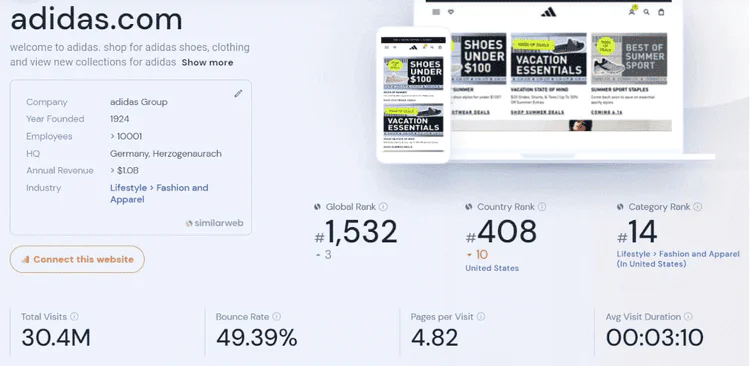
02 Monthly number of mentions
The monthly number of mentions shows how often people talk about the brand online.
It tells you how visible and popular the brand is. Higher mention numbers suggest a higher level of brand visibility. It also helps identify influential individuals who talk about your brand.
Monitoring media mentions is crucial during a crisis or reputation management situation. By tracking mentions and hashtags, you can assess the effectiveness of marketing campaigns and measure customer engagement.
During the last 30 days, Adidas was mentioned over 168k times. Instagram is the main source of mentions.

03 Marketing channels distribution
Distribution of marketing channels tells you how a brand’s marketing message reaches people.
By analyzing marketing channels like social media, email, and advertising, you can identify sources that deliver the most engagement, leads, or conversions for the brand.
What’s important, you can gain valuable insights about the target market by studying your competitors’ marketing channels.
This analysis can reveal where your competitors have an advantage. Armed with this information, you can allocate marketing budgets effectively.
Last month, most visits to adidas.com came directly to the site, accounting for 39% of desktop traffic. Organic Search was the second-highest traffic source, making up 28% of visits. Interestingly, the channel that was least utilized was Mail. That data indicate Adidas has strong brand awareness and invests in SEO.
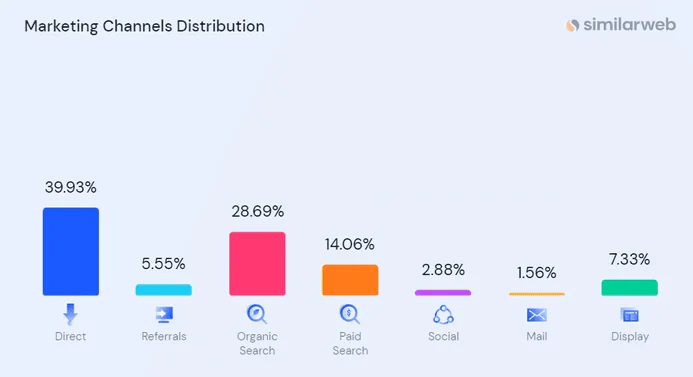
04 Social media and non-social reach
Reach metrics indicate the level of brand awareness among your target audience. A wider reach suggests that more people are becoming aware of your brand and its offerings. It helps track the growth of your brand’s visibility.
Social media reach measures the number of people exposed to your brand’s content through social media platforms.
Non-social reach refers to the reach achieved through other channels, such as traditional advertising, email marketing, or website traffic.
Both metrics provide insights into the size of your brand’s audience and the effectiveness of your brand strategy.
In the last 30 days, Adidas has reached 245 million people through social media and 280 million people through non-social media channels such as news, the web, forums, and blogs.
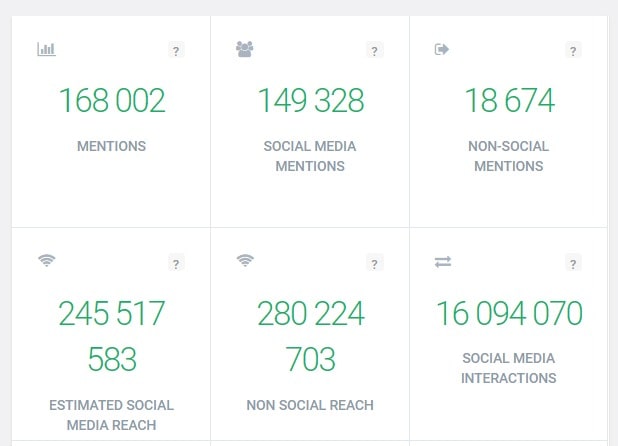
05 Engagement
To conduct a solid brand audit, you need to track engagement. It tells you how many people interact with your brand. Engagement reflects their interest and connection with your content, products, or services.

Discover our client’s success story — read the case study.
Low engagement may indicate areas for improvement. Analyzing engagement lets you see which content resonates with your audience and build trust. It also helps you understand your audience’s preferences and behaviors. Low engagement may indicate areas for improvement.
Engagement metrics are useful for influencer marketing and managing customer relationships. They help you assess the effectiveness of your brand voice and marketing efforts and measure the return on investment.
In the last 30 days, Adidas received 18k non-social mentions, 150k social media mentions, 838k social media shares, and 15m likes.
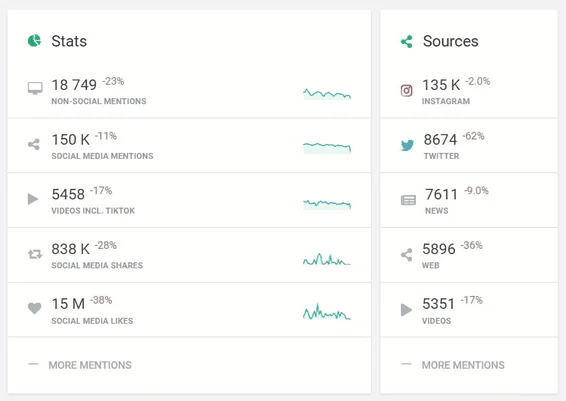
06 Presence Score
The Presence Score measures the brand’s online presence across various digital platforms, including social media, websites, blogs, and review sites. This metric helps evaluate the brand’s exposure to the target audience.
It’s an important brand analysis metric because it provides an overall assessment of the brand’s visibility. The higher Presence Score, the better.
The Presence Score of the Adidas brand is quite high.

Use the Brand24 tool to analyze any brand!
07 Top keywords
Top keywords show what your target audience is searching for, helping you understand their interests and preferences.
Analyzing competitors’ top keywords reveals opportunities to improve your own keyword strategy. Incorporating them into your content strategy improves your chances of ranking well in search engines, driving more traffic to your brand.
Also, tracking top keywords keeps you updated on emerging trends, enabling you to create timely and relevant content.
Here you can see keywords related to Adidas:
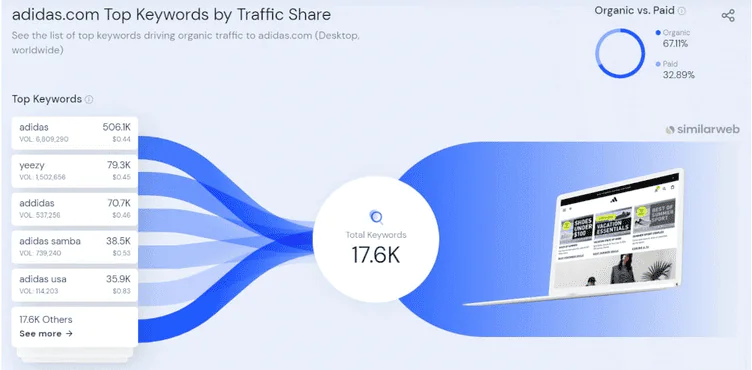
You can also check related keywords using the Ahrefs tool:
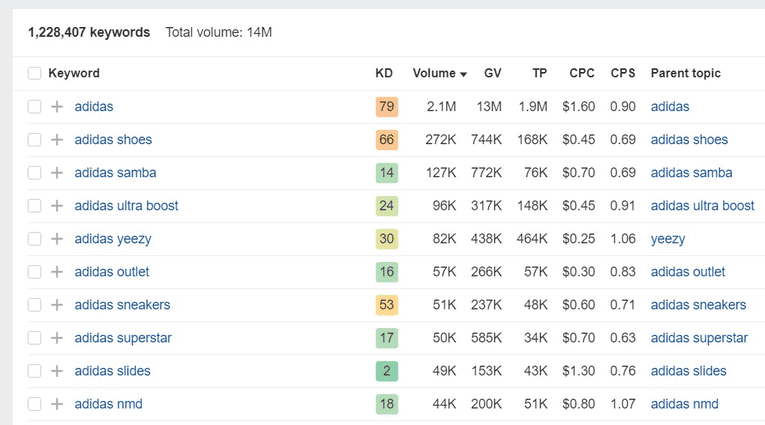
Tip: You can use those search terms to set up a media monitoring project and track their performance across the Internet.
08 Sentiment
Sentiment analysis shows how people feel about your brand, whether it’s positive, negative, or neutral. It helps you measure how satisfied customers are with it.
Mentions are a valuable source of feedback. Monitoring sentiment helps you identify negative sentiment spikes. This helps protect your brand’s reputation during crises.
The overall sentiment of Adidas is positive. In the last 30 days, the brand received 43k positive mentions, mainly from Instagram and Twitter.

09 Reputation Score
Reputation Score metrics help to measure brand reputation. Having a solid Reputation Score is crucial because it indicates how much people trust and believe in your brand’s credibility. This can have a positive impact on their purchasing decisions and brand loyalty.
A strong brand reputation sets your brand apart from competitors. It helps distinguish your brand as reliable, reputable, and preferred by customers, creating a competitive advantage in the market.
Over the past 30 days, Adidas’ Reputation Score has increased from 46 to 49.

10 Geography
Understanding the geographic locations where your brand is being targeted allows you to tailor your marketing efforts to specific regions.
With this knowledge, you can develop a brand strategy, marketing campaigns, messages, and promotions that are tailored to each region and resonate with their unique interests.
Adidas’s primary audience is from the United States, accounting for 73% of its customer base.
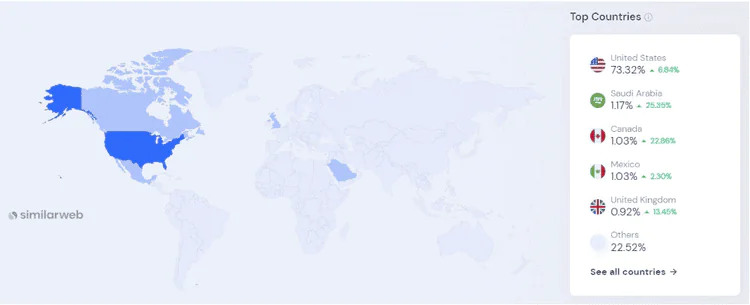
11 Audience demographics
Audience demographic is one of the most important parts of the brand analysis. Understanding the demographic profile of the audience helps brand owners tailor marketing strategies, create a brand identity and even build a new brand strategy.
Analyzing audience demographics enables you to segment your customer base and identify different groups with distinct characteristics and needs.
According to data provided by Similarweb, most of the visitors to adidas.com are male (55.98%), while 44.02% are female. The biggest group of desktop users belongs to the age range of 25-34.
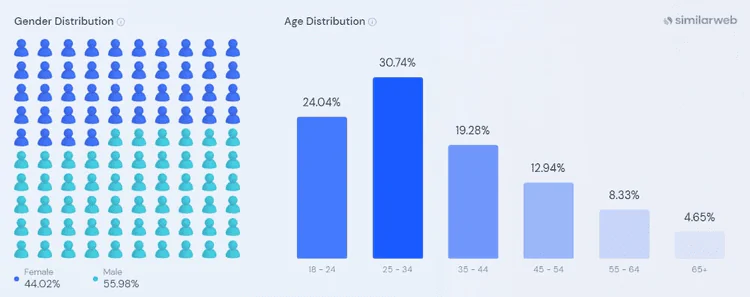
12 Audience interests
As a brand owner, you should know the interest of your target audience. By understanding what topics, themes, or types of content your audience finds interesting, you can create products and services that will meet customer needs.
Below, you will find a list of the top words mentioned by the Adidas audience in the past 30 days.
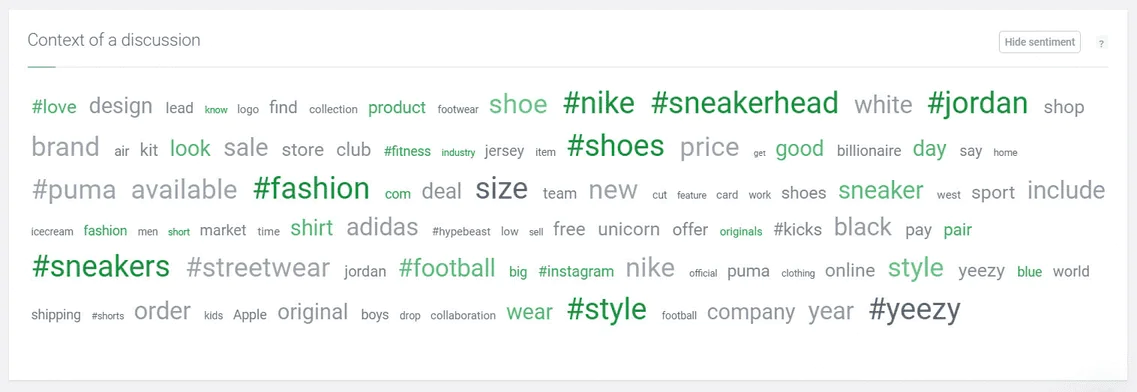
Importance of analyzing a brand
Whether you’re running a small business or a large corporation, it’s essential to take a closer look at your brand.
It’s not just about having an eye-catching logo and tagline. In today’s fast-paced and competitive market, it’s crucial to understand how your brand is perceived and performing.
Here are a few key reasons why analyzing your brand is so important:
- Understanding customer perceptions: To better serve your customers, it’s important to understand their preferences, needs, and expectations. You can gain this insight through market research, surveys, and monitoring online conversations. This information allows you to customize your brand messaging, products, and services to create a more meaningful and relevant customer experience.
- Enhancing brand strategy: Brand analysis provides valuable insights into your brand’s strengths, weaknesses, opportunities, and threats. By understanding your brand’s unique value proposition and how customers and competitors perceive it, you can develop a more effective strategy. This will help you align your brand with your target audience’s expectations and desires, making you stand out in a crowded marketplace.
- Building brand reputation: If you want to ensure your brand is a success, it’s super important to have a good reputation. One way to do this is to keep an eye on what people are saying about you. By checking customer feedback, online reviews, and social media sentiment, you can quickly spot any issues and fix them right away. This helps build trust with your customers, which can lead to more people recommending your brand and becoming loyal fans.
- Staying competitive: In today’s competitive market, monitoring your competitors and their branding strategies is essential. By analyzing their brands, you can assess their messaging, positioning, and market share. Armed with this knowledge, you can identify areas where you can stand out and innovate, ensuring that you stay ahead of the game.
- Measuring brand performance: Analyzing your brand’s performance provides valuable metrics and indicators of success. This way, you can see if your branding works well by checking customer loyalty, financial indicators, and how well your brand is known. Looking at the data can help you figure out what’s working and what could be better, so you can change your brand and marketing strategies if needed. It’s a smart way to stay on top of things and make informed decisions.
Use the AI-powered monitoring tool to analyze any brand!
Conclusion
To conduct a reliable brand analysis, you need to check the most important metrics.
In this article, I presented you with 12 key elements you should track to evaluate brand performance online.
They cover everything from how aware people are of your brand to how they feel about it, along with analyzing how engaged your customers are and how far your brand is reaching.
By keeping an eye on these metrics, you’ll be able to understand your brand better.
So, willing to know what your brand’s sentiment, non-social reach, and Presence Score are? Start a free trial now!





